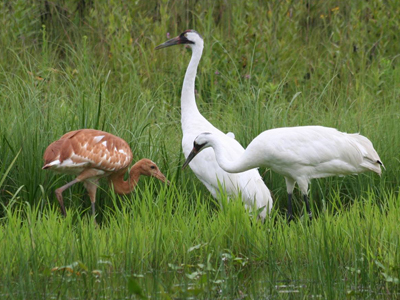 The Whooping Crane Eastern Partnership (WCEP) is just one element of a diverse strategy to save Whooping Cranes from extinction. The recent decision by the U.S. Fish and Wildlife Service (USFWS) to modify WCEP rearing and release methods addresses the changing needs in the recovery of this highly endangered species. These changes are only possible because of the great success of the program thus far. With more than 100 reintroduced Whooping Cranes successfully migrating to the southern U.S. and returning to nest in growing numbers in Wisconsin, we are now able to turn our attention to the next steps that will ensure they are successful as wild birds.
The Whooping Crane Eastern Partnership (WCEP) is just one element of a diverse strategy to save Whooping Cranes from extinction. The recent decision by the U.S. Fish and Wildlife Service (USFWS) to modify WCEP rearing and release methods addresses the changing needs in the recovery of this highly endangered species. These changes are only possible because of the great success of the program thus far. With more than 100 reintroduced Whooping Cranes successfully migrating to the southern U.S. and returning to nest in growing numbers in Wisconsin, we are now able to turn our attention to the next steps that will ensure they are successful as wild birds.
This document addresses questions you may have about these recent changes and what they mean for Whooping Cranes and your investment in the species and the International Cane Foundation. If you have additional questions, please click here to contact us.
What is “WCEP” and what is the International Crane Foundation’s role in this partnership?
The Whooping Crane Eastern Partnership (WCEP) is a group of non-profit organizations and government and state agencies formed to restore a migratory population of Whooping Cranes to eastern North America. Each independent partner takes on responsibility for specific activities, with all partners participating in governance. The International Crane Foundation is an original member of WCEP, with our roles including egg production, raising chicks for release, monitoring released birds, habitat research, and outreach and education.
What is WCEP’s goal? Is it actually achievable?
WCEP’s goal is to restore a migratory population of Whooping Cranes to eastern North America, and yes, we absolutely believe the goal is achievable! In fact, several key measures of success have already been accomplished. We now have a healthy wild population numbering more than 100 birds that successfully migrates between Wisconsin and the southeast U.S. The cranes are successfully pairing and nesting and egg production is increasing. The last step for any reintroduction effort is successful breeding in the wild so that the population is self-sustaining. The WCEP population has not yet successfully fledged chicks in large enough numbers to achieve this goal. The changes recently recommended for WCEP adapt rearing and release methods to address this challenge.
What changes in crane releases did the USFWS recommend for WCEP?
On January 22, 2016, USFWS announced recommendations modifying WCEP’s methods for Whooping Crane rearing and release. These changes emphasize less “artificial” methods, such as limiting the amount of time chicks interact with costumed staff. As a result, the decision recommends that the chicks should have as much contact and learning as possible with adult Whooping Cranes, including having as many chicks as possible reared by captive adult Whooping Cranes. To further achieve these goals, the ultralight-led migrations were eliminated, and other techniques that have been used (Direct Autumn Release, parent-rearing) are under review and will be modified.
Who made the decision to end the ultralight migrations and why?
The decision was made by USFWS, which “owns” all of the Whooping Cranes and their eggs, and the WCEP partners did not vote on the matter. The USFWS explained that the decision was made so that the partnership can focus on the next key phase of the WCEP program, ensuring that the birds nest successfully and are good parents.
Do these changes from USFWS mean something went wrong with the WCEP project?
WCEP has had many successes – there are more than 100 wild cranes in the population, birds are successfully migrating, and the number and locations of nests are growing. Although the cranes are nesting, they have not been successful hatching and rearing enough chicks to maintain the population without further releases. Now USFWS is asking WCEP to find solutions to these challenges that are critically needed for this reintroduction to be successful. WCEP can meet this challenge, and the International Crane Foundation will be a leader.
What’s next for the International Crane Foundation and Whooping Cranes?
We are busy preparing for another season of hatching, raising, and releasing Whooping Cranes (we expect the first eggs in late April)! We will continue to participate in and lead reintroduction efforts in Louisiana and Wisconsin. At the same time, we are working across the nation to make sure Whooping Crane recovery is successful – protecting habitat, monitoring wild birds, addressing shootings and other threats, and building awareness (learn more here). Your investment in this work has never been more important – thank you for your support!
